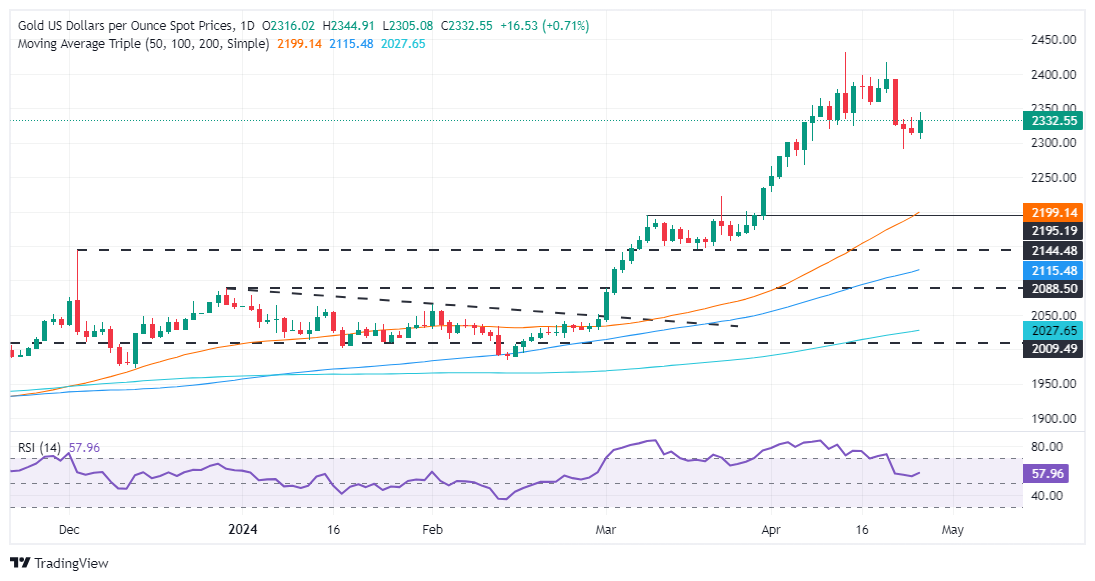- Gold rises after knowing the US GDP figures for the first quarter that were worse than expected.
- The sharp rise in first-quarter inflation to 3.7% tempers expectations of immediate Fed interest rate cuts and underpins the rise in Treasury yields.
- Fed officials maintain a cautious stance on monetary policy, echoing concerns about persistent inflationary pressure.
Gold prices advanced modestly during the North American session on Thursday, gaining more than 0.5% following the release of crucial economic data from the United States (US). GDP figures for the first quarter of 2024 disappointed expectations, increasing speculation that the US Federal Reserve (Fed) could reduce borrowing costs. However, inflation for the same period skyrocketed, which would delay interest rate cuts by the Fed.
The As analysts expected, the US economy would slow in 2024, but it did not do so by one percentage point in the first quarter. That would keep the “soft landing” narrative going, but core inflation in the first quarter of 2024 rose 3.7% quarter-on-quarter, above estimates and crushing the 2% recorded in the last quarter of 2023.
This justified the change in stance by Fed officials last week. Chairman Jerome Powell gave the green light, commenting: “Recent data show a lack of further progress in inflation this year.”
Those words were echoed by a slew of policymakers, most significantly by ultra-dovish Chicago Fed President Austan Goolsbee, who said: “The Fed's current tight monetary policy is appropriate.”
Daily Market Summary: Gold Price Rises Amid High US Yields, Weak USD
- Gold's advance continues despite the rise in US Treasury yields. The US 10-year note yield rose six basis points (bps) to 4.706%, while US real yields, which are closely inversely correlated with the gold metal, also rose the same amount, up to 2.296%.
- A weaker dollar also helps the yellow metal. The US Dollar Index (DXY) fell 0.22% to 105.59 points.
- US GDP for the first quarter of 2024 grew 1.6% quarter-on-quarter, below estimates of 2.5%, and below the 3.4% for the fourth quarter of 2023. The personal consumption expenditure (PCE) price index for the same period rose 3.7%, exceeding estimates of a 3.4% increase and above the 2% previous reading.
- Additionally, the U.S. labor market remains strong. Initial jobless claims for the week ending April 20 missed estimates of 214,000 and stood at 207,000, below the previous reading.
- Upcoming first-quarter GDP data and core PCE inflation will provide key information on the Fed's potential timing of interest rate cuts. Core PCE, the Fed's preferred measure of inflation, is expected to maintain a stable monthly growth of 0.3%. Additionally, the annual core PCE rate is expected to decline to 2.6% from 2.8% in February.
- Data from the Chicago Board of Trade (CBOT) suggests traders expect the federal funds rate to end 2024 at 5.035%, up from 4.98% on Wednesday.
Technical Analysis: Gold Price Approaches $2,330 as Buyers Take a Breath

Gold price rises, but faces resistance at $2,337, the April 24 high. A break of this last level would expose the psychological figure of $2,350, followed by the $2,400 mark. Once this supply zone is surpassed, the following increases will occur: the April 19 high at $2,417, followed by the all-time high of $2,431.
On the other hand, if the XAU/USD price falls below the daily low of April 15 at $2,324, this would pave the way to test $2,300. A break of this latter level would expose the April 23 low at $2,229, followed by the March 21 high at $2,222.
Frequently asked questions about Gold
Gold has played a key role in human history as it has been widely used as a store of value and medium of exchange. Today, apart from its brilliance and use for jewelry, the precious metal is considered a safe haven asset, meaning it is considered a good investment in turbulent times. Gold is also considered a hedge against inflation and currency depreciation, as it is not dependent on any issuer or government.
Central banks are the largest holders of Gold. In their aim to support their currencies in turbulent times, central banks tend to diversify their reserves and purchase Gold to improve the perception of strength of the economy and currency. High Gold reserves can be a source of confidence for the solvency of a country. Central banks added 1,136 tons of gold worth about $70 billion to their reserves in 2022, according to data from the World Gold Council. This is the largest annual purchase since records exist. Central banks in emerging economies such as China, India and Türkiye are rapidly increasing their gold reserves.
Gold has an inverse correlation with the US Dollar and US Treasuries, which are the main reserve and safe haven assets. When the Dollar depreciates, Gold tends to rise, allowing investors and central banks to diversify their assets in turbulent times. Gold is also inversely correlated with risk assets. A rally in the stock market tends to weaken the price of Gold, while sell-offs in riskier markets tend to favor the precious metal.
The price can move due to a wide range of factors. Geopolitical instability or fear of a deep recession can cause the price of Gold to rise rapidly due to its status as a safe haven asset. Being a non-yielding asset, Gold tends to rise with lower interest rates, while the higher cost of money usually weighs on the yellow metal. However, most of the movements depend on the behavior of the US Dollar (USD), as the asset is traded in dollars (XAU/USD). A strong Dollar tends to keep the price of Gold in check, while a weaker Dollar is likely to push up Gold prices.
Source: Fx Street
I am Joshua Winder, a senior-level journalist and editor at World Stock Market. I specialize in covering news related to the stock market and economic trends. With more than 8 years of experience in this field, I have become an expert in financial reporting.







